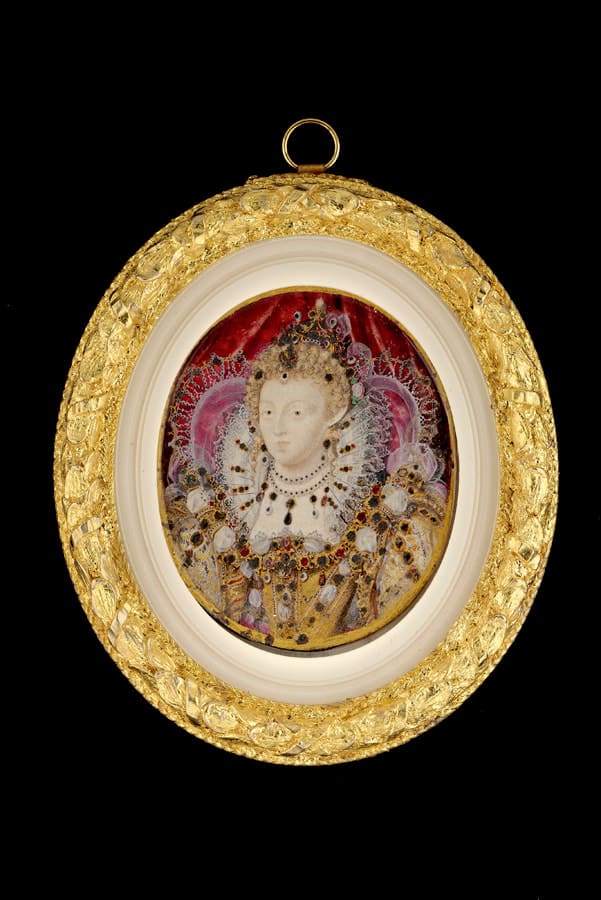
Nicholas Hilliard
Portrait miniature of Queen Elizabeth I, c. 1595
Watercolour
Oval, 2 3/16 in. (56 mm) high
Philip Mould & Co.
To view all current artworks for sale visit philipmould.com This hitherto unpublished miniature is one of the most important images of Elizabeth I from the last decade of her reign....
To view all current artworks for sale visit philipmould.com
Nicholas Hilliard had been held in continual favour by the Queen since their first encounter in about 1572 (she even, later, refused him permission to work abroad), and it is from Hilliard that we have the only record of Elizabeth sitting for a portrait, as related in his ‘Treatise concerning the Arte of Limning’. The Queen, Hilliard wrote, refused to have ‘any shadowe at all’ in her portraits, and, when sitting to Hilliard, chose a bright, sunlit location in the royal garden. Naturally, fewer shadows on Elizabeth’s ageing face meant fewer lines, and so it is unsurprising that nearly all of Elizabeth’s later portraits, including the present example, show such a brightly lit visage.
That, then, was the aesthetic reason for Elizabeth’s featureless faces. There was of course a political reason too. Elizabeth’s perilous dynastic position, as an elderly, unmarried monarch, and the last of the Tudor dynasty, meant that her image could not stress the traditional female charms of beauty, grace, and, after the 1570s, fertility. In fact, it had to stress the opposite. As soon as it became clear that she would not marry, Elizabeth was effectively de-sexed, and she was portrayed as a virtuous emblem of state, the Virgin Queen forsaking marriage for the good of the kingdom. Consequently, Elizabeth’s portraiture, closely controlled by the privy council, came to rely on the grandeur of costume and jewellery to convey her sovereign power.
Hilliard’s pre-eminent skill and talent for detail meant that he was perfectly placed to portray Elizabeth as the ‘Gloriana’ figure that she so desired. His earlier miniatures show the Queen in a less elaborate setting than that seen here. For example, in the 1586-7 miniature at the V&A, London [p.23-1975] the Queen’s face radiates from a large, plain white ruff, and the sobre black dress and spartan jewellery play a secondary role. In this example, however, the opposite is true.
Here, ten years later, the Queen’s face is drawn only with a few schematic lines, and she is deliberately bolstered by the surrounding flamboyance and bright red drapery of the background. She wears a meticulously rendered dress made of cloth-of-gold, with gold and pearl embroidered sleeves, while on the bodice we find richly embellished jewels; gold-set rubies, diamonds and dozens of pearls, the latter painted in white with silver-foil high-lights, which, although now-tarnished, would have dazzled the viewer. Elizabeth’s head, framed by gauze wings also embellished with pearls, is surmounted by a diamond-set crown, while in her hair is another elaborate jewel, a crescent-shaped gold-set ruby.
It would hardly be possible to paint a more flamboyant image of the Queen. We can be sure that Hilliard’s miniatures met with royal approval, for those of his rival, Isaac Oliver, were not so widely repeated. Oliver’s far more realistic likeness of 1592 [V&A, London] was too aged, and showed Elizabeth as toothless and gaunt. It misunderstood the fundamental premise that such miniatures were not intended as likenesses of the Queen, but as symbols of her. Hence Hilliard’s inclusion here of the crescent shaped jewel in Elizabeth’s hair, as an obvious reference to the purity of the goddess Diana. The delicately rendered rose seen on the right in the Queen’s hair alludes to the cult of Elizabeth as ‘Beauty’s Rose’, or ‘Stella Britannis’, the Star of Britain.
6
of
6